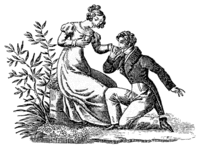| Revision as of 19:39, 15 June 2007 edit209.178.225.28 (talk) →Engagement rings← Previous edit | Revision as of 13:13, 19 June 2007 edit undo192.250.34.161 (talk)No edit summaryNext edit → | ||
| Line 3: | Line 3: | ||
| {{otheruses}} | {{otheruses}} | ||
| ] The Proposal]] | ] The Proposal]] | ||
| '''Bold text'''ALLISON & RYAN 6.11.2007!!!!!! | |||
| An '''engagement''' is an agreement or promise to ], and also refers to the time between proposal and marriage. During this period, a couple is said to be '''affianced,''' '''engaged to be married,''' or simply '''engaged.''' | An '''engagement''' is an agreement or promise to ], and also refers to the time between proposal and marriage. During this period, a couple is said to be '''affianced,''' '''engaged to be married,''' or simply '''engaged.''' | ||
Revision as of 13:13, 19 June 2007
"Engaged" redirects here. For For the play by W. S. Gilbert, see Engaged (play), see Engaged (disambiguation). "Fiance" and "Fiancee" redirect here. For Fiance, see Fiance (disambiguation). For other uses, see Engagement (disambiguation).
Bold textALLISON & RYAN 6.11.2007!!!!!!
An engagement is an agreement or promise to marry, and also refers to the time between proposal and marriage. During this period, a couple is said to be affianced, engaged to be married, or simply engaged.
The engagement period
The concept of an engagement period may have begun in 1215 at the Fourth Lateran Council, headed by Pope Innocent III, which decreed that "marriages are to be ... announced publicly in the churches by the priests during a suitable and fixed time, so that if legitimate impediments exist, they may be made known." The modern Western form of the practice of giving or exchanging engagement rings is traditionally thought to have begun in 1477 when Maximilian I, Holy Roman Emperor gave Mary of Burgundy a diamond ring as an engagement present.
Engagement rings
Main article: Engagement ring
In the United States, Canada, and the United Kingdom, an engagement ring is worn on the fourth finger of the left hand; the custom in Continental Europe and other countries is to wear it on the right hand. This tradition is thought to be from the Romans, who believed this finger to be the beginning of the vena amoris ("vein of love"), the vein that leads to the heart. Romantic rings from the time of the Roman Empire and from as far back as 4 AD often resemble the Celtic Claddagh symbol (two hands clasping a heart) and so it is thought that this was used as some symbol of love and commitment between a man and a woman. Some others suggest that the rings could be symbolically linked to slave shackles, and thus symbolize the future bondage of husband and wife. However, this is all speculation.
Engagement parties
Some, but not all, engagements are honored with an engagement party, often hosted by the bride's parents. It may be formal or informal, and is typically held between six months and a year before the wedding. Traditionally, engagement parties allowed the bride's parents to announce the impending marriage to friends and families. Today, such an event can either be an announcement or simply a celebration.
Related terms
Fiancé(e)
A man who is engaged to be married is called his partner's fiancé; a woman similarly engaged is called her partner's fiancée. These words are pronounced identically in English; the separate feminine form exists because of the inflectional morphology of grammatical gender in French, where the term originated. The term fiancé(e) is also sometimes used as a euphemism for a live-in lover, as was particularly common in tabloid newspapers during the 1990s.

Proposal
Main article: Proposal of marriageEngagement is most often initiated by a proposal of marriage, or simply a proposal. The proposal often has a ritual quality, involving the presentation of the engagement ring and a formalized asking of a question such as "Will you marry me?" In a heterosexual relationship, the man traditionally proposes to the woman, but this is no longer universal. In Ireland the 29th of February is said to be the one day (coming round only once every four years) when a woman can propose to her partner. In the United States, it is traditional to call friends and family members immediately after the proposal has been accepted.
Betrothal
Engagement is similar to betrothal, and the two terms are sometimes used interchangeably. However, betrothal often refers to agreements involving not only the couple but their families; the concept sometimes has a connotation of arranged marriage. Furthermore, betrothals, though they can be broken, often have binding legal implications lacking in engagements.
Breach of Promise
Main article: Breach of PromiseIn some jurisdictions, until the 20th century, it was possible for a woman (but almost never a man), to sue if an engagement was broken, based on denial of the chance to "establish herself" and possible damage to her reputation.
See also
Notes
- http://www.fordham.edu/halsall/basis/lateran4.html
- http://www.utunumsint.org/lateran%20iv.htm
- http://web.archive.org/web/20050316114519/http://can.adiamondisforever.com/F/f5b.htm
- http://www.royalfinejewelers.com/Articles/Article.aspx?id=52